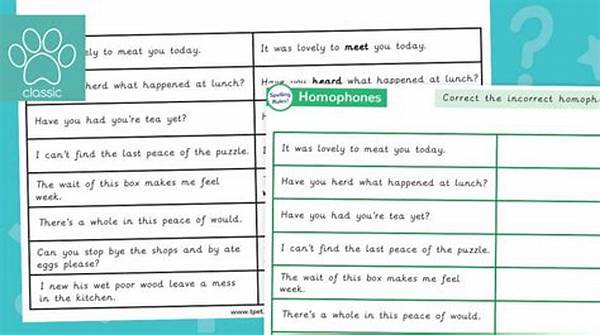Language is a magnificent tool, but it can also be a tricky beast, especially when it comes to homophones—those pesky words that sound the same but have different meanings and spellings. Mistakes in using homophones are more common than you think, and they can change the meaning of a sentence entirely. If you’ve ever mixed up “their,” “there,” and “they’re,” you’re not alone. Thankfully, there are simple strategies for correcting homophone spelling mistakes, ensuring your writing conveys the intended message without a hitch.
The Challenge of Homophones
Understanding the challenge of homophones is the first step toward correcting homophone spelling mistakes. Homophones are words with identical pronunciations but different meanings and spellings, such as “to,” “too,” and “two.” These words often trip up writers, leading to common spelling errors that can alter the meaning of sentences. Imagine writing a heartfelt note saying, “I hope you’re having a grate day,” instead of using “great.” Such slips are small but significant. So, how can we minimize these errors? Start by making a list of homophones that commonly give you trouble. Create mnemonics or simple memory aids to distinguish them. Reading a lot and paying attention to context can also help reinforce correct spelling. Using grammar and spell-check tools is another effective method for identifying and correcting homophone spelling mistakes. These tools highlight errors that might have slipped through the net, assisting you in refining your writing before it reaches your audience.
Tips for Mastering Homophone Usage
1. Create Flashcards: One practical tip for correcting homophone spelling mistakes is to make flashcards of commonly confused words. Include their meanings and examples to help reinforce the differences.
2. Use Mnemonics: Develop easy-to-remember mnemonics. For example, recall that “principal” is your “pal” because a school principal can be friendly, unlike the “principle” which is a rule.
3. Read Aloud: Correcting homophone spelling mistakes can sometimes be as simple as reading your text out loud. Hearing the words can help you spot errors.
4. Peer Review: Ask someone else to read your work. A fresh set of eyes can be invaluable in catching and correcting homophone spelling mistakes you might have missed.
5. Practice Regularly: Exposure and repetition are key. Engage in writing exercises that focus on commonly confused homophones to build familiarity and accuracy in use.
Understanding Context for Accuracy
The importance of context cannot be overstated when it comes to correcting homophone spelling mistakes. Context is your best ally in distinguishing which word fits where. Even though “pair,” “pare,” and “pear” sound the same, their usage within a sentence should guide you. If you’re talking about fruit, “pear” is your go-to. When you’re trimming, think “pare,” and if something’s in a set of two, it’s “pair.” Thus, paying attention to the context ensures that the chosen homophone aligns with the intended meaning. Moreover, immersing yourself in reading—be it books, articles, or essays—exposes you to the correct usage of homophones in various contexts. As you read, you’ll naturally become more adept at figuring out which word belongs where, reducing the likelihood of homophone slip-ups in your writing.
Common Homophone Errors and How to Avoid Them
To tackle the issue of homophone errors head-on, one must first recognize common pitfalls. Words like “it’s” vs. “its,” “your” vs. “you’re,” and “there” vs. “their” are frequent offenders. Correcting homophone spelling mistakes involves patience and detailed attention to each word’s role in a sentence. Forming a habit of stopping to question each choice can drastically minimize mistakes. For instance, “it’s” is a contraction for “it is” while “its” shows possession. By breaking down sentences this way, and possibly keeping a reference chart handy, these mistakes can be corrected before they occur, enhancing the clarity and professionalism of your writing.
Tools and Techniques for Error-Free Writing
Embracing available tools and honing specialized techniques can greatly aid in correcting homophone spelling mistakes. Software like Grammarly or the built-in spell-checking feature in word processors can detect inconsistencies or strange word usages, pointing you towards possible errors. Focus not just on correction but on training: simulate writing conditions with exercises or games aimed at boosting your ability to differentiate homophones. Encourage self-education through apps that challenge you to fill in the blanks with the appropriate homophone. These methods serve double duty: they correct mistakes and gradually build a more intuitive understanding of homophone usage.
Bringing it All Together
Correcting homophone spelling mistakes is an essential skill for anyone wielding the power of words. Through regular practice, awareness, and the effective use of tools, these common errors can transform into moments of learning rather than frustration. Whether you’re drafting a casual email or penning a crucial business document, clarity is key, and the right homophone can make all the difference. Keep this guide handy as you navigate the sometimes murky waters of language, confident in your ability to convey exactly what you mean. Lean into the process, and soon enough, error-free writing will become second nature.
Summarizing the Importance of Accuracy
As we wrap up our exploration into correcting homophone spelling mistakes, it’s clear that precision in writing not only demonstrates mastery over language but also shows respect for the reader. While it might seem daunting at first, with consistent effort and attention to detail, these errors can be eradicated from your writing repertoire. Remember, language is an evolving art form, and every writer is a lifelong learner. By embracing strategies and tools, you equip yourself with the skills needed to tackle homophone challenges head-on, ensuring your writing remains clear, professional, and impactful. Happy writing!
